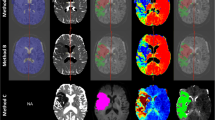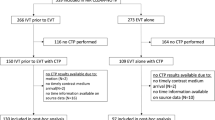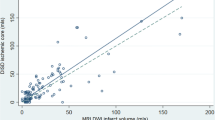Abstract
Purpose
Patients with large vessel occlusion and target mismatch on imaging may be thrombectomy candidates in the extended time window. However, the ability of imaging modalities including non-contrast CT Alberta Stroke Program Early Computed Tomographic Scoring (CT ASPECTS), CT angiography collateral score (CTA-CS), diffusion-weighted MRI ASPECTS (DWI ASPECTS), DWI lesion volume, and DWI volume with clinical deficit (DWI + NIHSS), to identify mismatch is unknown.
Methods
We defined target mismatch as core infarct (DWI volume) of < 70 mL, mismatch volume (tissue with TMax > 6 s) of ≥ 15 mL, and mismatch ratio of ≥ 1.8. Using experimental dismantling design, ability to identify this profile was determined for each imaging modality independently (phase 1) and then with knowledge from preceding modalities (phase 2). We used a generalized mixed model assuming binary distribution with PROC GLIMMIX/SAS for analysis.
Results
We identified 32 patients with anterior circulation occlusions, presenting > 6 h from symptom onset, with National Institute of Health Stroke Scale of ≥ 6, who had CT and MR before thrombectomy. Sensitivities for identifying target mismatch increased modestly from 88% for NCCT to 91% with the addition of CTA-CS, and up to 100% for all MR-based modalities. Significant gains in specificity were observed from successive tests (29, 19, and 16% increase for DWI ASPECTS, DWI volume, and DWI + NIHSS, respectively).
Conclusions
The combination of NCCT ASPECTS and CTA-CS has high sensitivity for identifying the target mismatch in the extended time window. However, there are gains in specificity with MRI-based imaging, potentially identifying treatment candidates who may have been excluded based on CT imaging alone.

Similar content being viewed by others
Abbreviations
- CSC:
-
comprehensive stroke center
- PSC:
-
primary stroke center
- CTA-CS:
-
CTA collateral score
- ELVO:
-
emergent large vessel occlusion
- NCCT:
-
non-contrast CT
- NIHSS:
-
National Institutes of Health Stroke Scale
- NPV:
-
negative predictive value
- PPV:
-
positive predictive value
- TMM:
-
target mismatch
- TSLW:
-
time last seen well
References
Berkhemer OA, Fransen PS, Beumer D et al (2015) A randomized trial of intraarterial treatment for acute ischemic stroke. N Engl J Med 372(1):11–20. https://doi.org/10.1056/NEJMoa1411587 published online first: Epub date
Campbell BC, Mitchell PJ, Kleinig TJ et al (2015) Endovascular therapy for ischemic stroke with perfusion-imaging selection. N Engl J Med. https://doi.org/10.1056/NEJMoa1414792 published online first: Epub date
Goyal M, Demchuk AM, Menon BK et al (2015) Randomized assessment of rapid endovascular treatment of ischemic stroke. N Engl J Med. https://doi.org/10.1056/NEJMoa1414905 published online first: Epub date
Jovin TG, Chamorro A, Cobo E et al (2015) Thrombectomy within 8 hours after symptom onset in ischemic stroke. N Engl J Med. https://doi.org/10.1056/NEJMoa1503780 published online first: Epub date
Powers WJ, Derdeyn CP, Biller J et al (2015, 2015) AHA/ASA focused update of the 2013 guidelines for the early management of patients with acute ischemic stroke regarding endovascular treatment: a guideline for healthcare professionals from the American Heart Association/American Stroke Association. Stroke. https://doi.org/10.1161/STR.0000000000000074 published online first: Epub date
Saver JL, Goyal M, Bonafe A et al (2015) Stent-retriever thrombectomy after intravenous t-PA vs. t-PA alone in stroke. N Engl J Med. https://doi.org/10.1056/NEJMoa1415061 published online first: Epub date
Bracard S, Ducrocq X, Mas JL et al (2016) Mechanical thrombectomy after intravenous alteplase versus alteplase alone after stroke (THRACE): a randomised controlled trial. Lancet Neurol 15(11):1138–1147. https://doi.org/10.1016/S1474-4422(16)30177-6 published online first: Epub date
Albers GW, Lansberg MG, Kemp S et al (2017) A multicenter randomized controlled trial of endovascular therapy following imaging evaluation for ischemic stroke (DEFUSE 3). Int J Stroke 12(8):896–905. https://doi.org/10.1177/1747493017701147 published online first: Epub date
Jovin TG, Saver JL, Ribo M et al (2017) Diffusion-weighted imaging or computerized tomography perfusion assessment with clinical mismatch in the triage of wake up and late presenting strokes undergoing neurointervention with Trevo (DAWN) trial methods. Int J Stroke 12(6):641–652. https://doi.org/10.1177/1747493017710341 published online first: Epub date
Nogueira RG, Jadhav AP, Haussen DC et al (2017) Thrombectomy 6 to 24 hours after stroke with a mismatch between deficit and infarct. N Engl J Med. https://doi.org/10.1056/NEJMoa1706442 published online first: Epub date
Turc G, Maier B, Naggara O et al (2016) Clinical scales do not reliably identify acute ischemic stroke patients with large-artery occlusion. Stroke 47(6):1466–1472. https://doi.org/10.1161/STROKEAHA.116.013144 published online first: Epub date
Cheng-Ching E, Frontera JA, Man S et al (2015) Degree of collaterals and not time is the determining factor of core infarct volume within 6 hours of stroke onset. AJNR Am J Neuroradiol. https://doi.org/10.3174/ajnr.A4274 published online first: Epub date
Nambiar V, Sohn SI, Almekhlafi MA et al (2014) CTA collateral status and response to recanalization in patients with acute ischemic stroke. AJNR Am J Neuroradiol 35(5):884–890. https://doi.org/10.3174/ajnr.A3817 published online first: Epub date
Souza LC, Yoo AJ, Chaudhry ZA et al (2012) Malignant CTA collateral profile is highly specific for large admission DWI infarct core and poor outcome in acute stroke. AJNR Am J Neuroradiol 33(7):1331–1336. https://doi.org/10.3174/ajnr.A2985 published online first: Epub date
Menon BK, d'Esterre CD, Qazi EM et al (2015) Multiphase CT angiography: a new tool for the imaging triage of patients with acute ischemic stroke. Radiology:142256. https://doi.org/10.1148/radiol.15142256 published online first: Epub date
Jovin TG, Liebeskind DS, Gupta R et al (2011) Imaging-based endovascular therapy for acute ischemic stroke due to proximal intracranial anterior circulation occlusion treated beyond 8 hours from time last seen well: retrospective multicenter analysis of 237 consecutive patients. Stroke 42(8):2206–2211. https://doi.org/10.1161/STROKEAHA.110.604223 published online first: Epub date
McTaggart RA, Yaghi S, Sacchetti DC et al (2017) Mechanical embolectomy for acute ischemic stroke beyond six hours from symptom onset using MRI based perfusion imaging. J Neurol Sci 375:395–400. https://doi.org/10.1016/j.jns.2017.02.044 published online first: Epub date
Rudkin S, Cerejo R, Tayal A, Goldberg MF (2018) Imaging of acute ischemic stroke. Emerg Radiol 25:659–672. https://doi.org/10.1007/s10140-018-1623-x published online first: Epub date
Rahman WT, Griauzde J, Chaudhary N, Pandey AS, Gemmete JJ, Chong ST (2017) Neurovascular emergencies: imaging diagnosis and neurointerventional treatment. Emerg Radiol 24:183–193. https://doi.org/10.1007/s10140-016-1450-x published online first: Epub date
Goyal M, Fargen KM, Menon BK (2014) Acute stroke, Bayes’ theorem and the art and science of emergency decision-making. J Neurointerv Surg 6(4):256–259. https://doi.org/10.1136/neurintsurg-2013-011056 published online first: Epub date
Nagel S, Herweh C, Rolf Pfaff JA, et al. (2018) Simplified selection criteria for patients with longer or unknown time to treatment preduct good outcome after mechanical thrombectomy. J Neuroint Surg. Published online first. https://doi.org/10.1136/neurintsurg-2018-014347
de Margerie-Mellon C, Turc G, Tisserand M et al (2013) Can DWI-ASPECTS substitute for lesion volume in acute stroke? Stroke 44(12):3565–3567. https://doi.org/10.1161/STROKEAHA.113.003047 published online first: Epub date
Desilles JP, Consoli A, Redjem H et al (2017) Successful reperfusion with mechanical thrombectomy is associated with reduced disability and mortality in patients with pretreatment diffusion-weighted imaging-Alberta Stroke Program Early Computed Tomography Score </=6. Stroke 48(4):963–969. https://doi.org/10.1161/STROKEAHA.116.015202 published online first: Epub date
Gilgen MD, Klimek D, Liesirova KT et al (2015) Younger stroke patients with large pretreatment diffusion-weighted imaging lesions may benefit from endovascular treatment. Stroke 46(9):2510–2516. https://doi.org/10.1161/STROKEAHA.115.010250 published online first: Epub date
McTaggart RA, Jovin TG, Lansberg MG et al (2014) Alberta Stroke Program Early Computed Tomographic Scoring performance in a series of patients undergoing computed tomography and MRI: reader agreement, modality agreement, and outcome prediction. Stroke. https://doi.org/10.1161/STROKEAHA.114.006564 published online first: Epub date
Hernandez M, San Roman L, Davalos A , et al. (2016) Imaging predictors of good clinical outcome: results from the highly effective reperfusion evaluated in multiple endovascular stroke trials (HERMES). Oral presentation from the World Stroke Congress
Campbell BC, Majoie CB, Menon BK, et al. (2017) The association between baseline ischemic core volume and benefit of endovascular thrombectomy in pooled data from six randomized trials. Oral presentation from the International Stroke Conference
Lingsma H, Companje K, Broers M, et al. (2017) Is infarct volume on CT a useful proxy for functional outcome? Results from the MR CLEAN trial. Oral presentation from the European Stroke Organisation Conference
Author information
Authors and Affiliations
Corresponding author
Ethics declarations
Conflict of interest
The authors declare that they have no conflict of interest.
Additional information
Publisher’s note
Springer Nature remains neutral with regard to jurisdictional claims in published maps and institutional affiliations.
Rights and permissions
About this article
Cite this article
DiBiasio, E.L., Jayaraman, M.V., Goyal, M. et al. Dismantling the ability of CT and MRI to identify the target mismatch profile in patients with anterior circulation large vessel occlusion beyond six hours from symptom onset. Emerg Radiol 26, 401–408 (2019). https://doi.org/10.1007/s10140-019-01686-z
Received:
Accepted:
Published:
Issue Date:
DOI: https://doi.org/10.1007/s10140-019-01686-z




